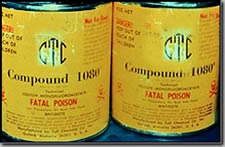Help Us Ban Compound 1080

Cans of Compound 1080 poison
Since our inception we have fought for a
worldwide ban on the deadly poison sodium fluoroacetate, aka Compound 1080.
Just one teaspoon could kill 100 people. We are working to eliminate Compound 1080 for good. Fact sheet
Support Legislation to Ban Compound 1080 in the U.S.
May 2019 - We are pleased to announce that the federal bill we've been working on for a nationwide ban on two deadly and indiscriminate poisons used for wildlife control--Compound 1080 and the sodium cyanide used in M-44s--was reintroduced in the U.S. House of Representatives by Congressman Peter DeFazio (D-Oregon) on May 2, 2019. The new bill is called the "Chemical Poisons Reduction Act of 2019," H.R. 2471, aka "Canyon's Law," in honor of former M-44 victim (and now activist) Canyon Mansfield of Pocatello, Idaho.
This bipartisan legislation, co-introduced with Rep. Matt Gaetz (R-Florida), is gaining significant cosponsorship, as it is common-sense, tax-saving, and nonpartisan. It should be supported without resistance as an essential public safety measure by all elected officials.
- Read press release from Rep. Peter DeFazio announcing bill
- Text of bill, H.R. 2471, "The Chemical Poisons Reduction Act of 2019," will soon be posted at this link
- Track the bill as it moves through Congress
- Find your Representative and urge them to sign on to and/or support H.R. 2471, the Chemical Poisons Reduction Act of 2019. Then spread the word to every possible person.
- Follow us on Faceboook for the latest updates.

Pets are at great risk of exposure
to
poisons like Compound 1080
Compound 1080 Victim?
Brooke and Cliff Everest of Bozeman, MT, lost their beloved dog, an American Brittany named Bea, whiile on a rafting trip on the White River in Utah. Bea suffered the agonizing and classic symptoms of Compound 1080 poisoning after an encounter with a sheep carcass.
Read their letter
| Read press release
What is Compound 1080?
It’s toxic! One teaspoon of Compound 1080 could kill 100 people. And there is no known antidote. It is colorless, has no odor or taste, and it dissolves easily in water. The Environmental Protection Agency (EPA) has placed sodium fluoroacetate—Compound 1080—in the Toxicity Category I indicating the highest degree of acute toxicity, for acute oral toxicity.
Once exposed, victims of 1080 poisoning die slowly. Symptoms are not immediate—they begin to appear half an hour or more after exposure and may last from hours to days. Symptoms typically include a cycle of repeated vomiting, involuntary hyperextension of the limbs, convulsions, and collapse. Victims can also experience heightened anxiety, hallucination, intense pain, and deep depression. Compound 1080 is so potent that animals eating tainted carcasses—even months after that animal has died—can succumb to secondary poisoning.
With the new specter of terrorism, why does the government continue to support production and export of one of the world's deadliest poisons?
- Read our esssay, "Two Killers that Need to Go," about Compound 1080, lethal M-44 sodium cyanide devices, and legislation currently in the works to ban both
- Read our comprehensive "Ban 1080 Newsletter," published in Winter 2002.
History
Building on research conducted by a Belgian scientist at the end of the 19th century, Compound 1080--sodium fluoroacetate—was developed in the U.S. as a rodenticide and mammalian predacide. Its use for these purposes in the U.S. began in the 1940s.
In 1972 President Nixon issued Executive Order 11643 banning the use of poisons to control predators on Federal lands. Shortly thereafter, the EPA issued PR Notice 72-2 that cancelled all registered predator control uses of sodium fluoroacetate, sodium cyanide, and strychnine. Despite the ban, pre-1972 stockpiles were never recalled or destroyed and this poison is still illegally used today to kill wolves, coyotes, and eagles.
Predator Defense Keeps Compound 1080 Out of Oregon
Predator Defense led a three-year campaign to keep Compound 1080 collars out of Oregon. After the EPA and Oregon’s Department of Agriculture gave a green light for the collars use, Predator Defense went to Oregon’s Governor, John Kitzhaber. As an emergency room physician, Governor Kitzhaber recognized that if poisons are present they will fall into the wrong hands. He assured Predator Defense that he would work to have its use banned. The Governor asked the USDA to voluntarily pull the registration so these toxic collars would never be used in Oregon. In 1998 it became illegal to use Compound 1080 in Oregon.
Illegal Use of Compound 1080 Still Killing Wildlife and Pets
Wildlife law enforcement officials have documented Compound 1080 poisoning of wolves on national forests in Central Idaho. In Grand Junction, Colorado, in just one incident, Compound 1080 killed approximately 30 pets and at least 35 birds. Because of the time lapse between ingesting this poison and the onset of sickness, as well as the incidence of secondary poisonings, the actual body count is likely much higher than can be documented.
1080 Livestock Protection Collars
Legal use of this poison began again in 1985 when the Environmental Protection Agency granted the U.S. Department of Interior registration for the use of Compound 1080 in the form of toxic collars worn by sheep and goats. By then the device was called the Livestock Protection Collar (LPC). In 1986, the authority for the use of these devices was transferred to U.S. Department of Agriculture (USDA), Animal and Plant Health Inspection Service (APHIS), Wildlife Services (formally Animal Damage Control).
Worn around an animal’s neck, the collar contains two rubber bladders holding Compound 1080 which will be ingested if a predator, such as a coyote or dog, pierces the collar while attempting to take down the animal. These toxic collars are the only legal way Compound 1080 can be used in the U.S. and USDA APHIS’s Wildlife Services is the only agency registered to use them. Wildlife Services is now allowed to use these collars in Idaho, Montana, New Mexico, South Dakota, Texas, Utah, West Virginia, and Wyoming.
The World’s Only Known Manufacturer of Compound 1080
The Tull Chemical Company in Oxford, Alabama is the only legal producer of Compound 1080 in the U.S. It is a small, family-owned business that has been making this toxin for decades. Most of the Compound 1080 is exported to New Zealand.
- Threat leads NZ authorities to ask about local plant's customers -
Anniston Star, Mar. 11, 2015
Go to Archives and see PredatorPress, Winter 2002 for more on Compound 1080 and Predator Defense’s field investigation in Alabama.
Compound 1080 in the News
Banned poison was used to kill wolf
- Idaho Mountain Express, Oct. 21, 2016
Threat leads NZ authorities to ask about local plant's customers
- Anniston Star, March 11, 2015
Wildlife investigators: Poison killed Colorado wolf
- Associated Press, Jan. 10, 2011
Predator Poison Killing Central Idaho Dogs
- Associated Press, May 15, 2010
Idaho Falls Post Register reports on Compound 1080 Killing Dogs in Idaho
- comments by Melissa Waage on NRDC staff blog, May 15, 2010
Alabama Congressman Tries to Sabotage Wildlife Poison Bill
- John Fleming, Anniston Star, Aug. 19, 2008
Predator Poison: DeFazio Plans to Ban Deadly Toxins
- Camilla Mortensen, Eugene Weekly, Nov. 15, 2007
1080 Is Not a Humane Poison: International Journal Publishes RSPCA Paper
- RSPCA Media Release, Nov. 11-15, 2007
Rep. DeFazio Pushes Ban of Alabama-Made Poison Exported to NZ
- Jay Reeves, Associated Press, Nov. 8, 2007
DeFazio Supports Ban on 1080
- Kera Abraham, Eugene Weekly, Jan. 12, 2006
CIA Report Cites Iraq’s Test of [Coyote] Poison
- by Michael Milstein, The Oregonian, May 28, 2005
1080 Found in Iraq by Survey Group
- George Smith, Ph.D., GlobalSecurity.org, May 25, 2005
Maker of Lethal Chemical Fights a Ban
- Jay Reeves, Washington Post, Dec. 19, 2004
Alabama Poison Plant Targeted Over Environmental Terrorism
- Jay Reeves, Associated Press, Dec. 12, 2004
Wolf Poisons Raises Alarms About Its Terrorism Potential
- Michael Milstein, The Oregonian, Nov. 3, 2004
Dog Poisonings As Terrorism
- Todd Wilkinson, Headwaters News, Aug. 5, 2004
Congressman wants Tull Chemical in Oxford Closed
- Charlotte Tubbs, Annison Star, Mar. 6, 2004
Saddam Colonel "Saw Thousands Murdered" (with Compound 1080)
- Steve Boggan, The Evening Standard (London), Ap. 17, 2003
Group Seeks Federal Ban Of Poison Used On Coyotes
- Michael Milstein, The Oregonian, Dec. 5, 2001
Statement Regarding Toxicity of Sodium Fluoroacetate
- Arbor Occupational Medicine, Nov. 12, 2001
Compound 1080 in New Zealand
Watch documentaries by award-wining filmmakers, TheGrafBoys, about the use of 1080 in New Zealand, where it is broadcast from aircraft to kill possums, but also kills deer, horses, dogs, and other animals:
- Poisoning Paradise - Ecocide New Zealand takes you into the drop-zone of aerial 1080 operations, beneath the canopy, where the birds and animals die. This film won four international awards and fully exposes the truth about a culture that is an international embarrassment.
- A Shadow of Doubt - Preview of documentary demonstrating "in the field" dangers of the effects of 1080 poison
- 1080 Poison in New Zealand - documents the indiscriminate nature of 1080 poisoning
Learn more about the use of 1080 in New Zealand:
Read about the link between 1080 use in New Zealand and a family-owned American chemical plant, Tull Chemical Company in Alabama. We investigated Tull in 2001-2002.
- Threat leads NZ authorities to ask about local plant's customers - Anniston Star, Mar. 11, 2015
